#DS91sttime: Looking back via Season Three Episodes
April 17, 2013 in #DS91sttime, General Topics
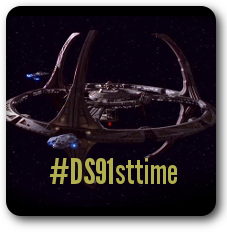 I just finished “Meridian“, “Defiant“, and “Fascination“.If you take these three episodes, break them over the rock of analysis like some caveman cracking open an egg, you’ll see in the yoke everything Deep Space Nine has been about until this mid-season three point.
I just finished “Meridian“, “Defiant“, and “Fascination“.If you take these three episodes, break them over the rock of analysis like some caveman cracking open an egg, you’ll see in the yoke everything Deep Space Nine has been about until this mid-season three point.
This is a show defined by what it wants to be almost as much as what it is. What I most respect about DS9, so far, is it is always pushing itself to be bigger than it was two or three episodes prior. It exudes gusto. By season three, it’s just about gotten a sense of itself, but the journey has been rough.
Deep Space Nine was a bit of a wild beast when released into the Star Trek pantheon. You get the impression that—prior to filming the pilot—the show’s producers and writers were sitting around on-fire to take a different tract, not just on Trek but its approach to storytelling. It became obvious to me during the first season that no one, not even the show’s writers, seemed to know quite what they wanted to do with it after it debuted. The results (in said first season) are like someone decided to chuck some cage-kept animal into the wild, and just see what it tore into first.
After the pilot (“Emissary”) was in the net, realities seemed to have set in. They realized the show’s chief plot engine–the wormhole and the gamma quadrant opposite–were largely undefined. They had characters even more exotic than TNG’s lineup, and they didn’t know what to do with them. They were unclear how quickly to move toward the distant horizon called The Dominion War (if that destination had even been sighted yet).
Practical considerations piled up, too: here was a show rushed out too early, in my opinion, needlessly placed on the networks during the end seasons of The Next Generation. The strategy was surely to ride a hit’s coattails for a little boost out the gate, but it put a lot of workload on people involved in both projects, and many of the first episodes speak of hamstringing. Even in season three, you still see traces of the show’s early mistakes.
Like “Meridian“, for example.
In “Meridian” the USS Defiant, the show’s pocket battleship, discovers a planet phasing in and out of reality on a clockwork basis. But this is actually a love story, crammed from start to resolution over the span of forty-five minutes, undertaken by a woman ready to throw away her career and live in a quasi-energy state with a man she just met. And this is Dax doing this—a person who carries the influence of hundreds of years of knowledge and personal growth within her.This episode has huge value for viewers of Deep Space Nine as a point of discussion, despite being largely forgettable as a piece of entertainment. It shows us what happens when the series disregards its own looming premises in an effort to try the episodic format of The Next Generation. In this case, spitting in the face of canon starts from the very beginning , with Commander Sisko’s claim that he’s encouraged Star Fleet to let them keep exploring the Gamma Quadrant, despite the Dominion threat. Because even though the Dominion waxed a Galaxy-class starship a few episodes back, along with several Bajoran colonies (“The Search, Part II”), the Feds will still be cool sending a ship the Dominion already defeated once back into the enemy’s space. Makes perfect sense.
The real reason episodes like this were done, and might continue to be done after “Meridian” (I shall see), is that until the Dominion War proper settled in the writers seemed to have thought they needed a way to get back to the bones of Star Trek. I think they were scared. It’s obvious they thought they had a Trek show (of which all previous incarnations were classically centered on exploration) grounded by an unsuccessful setup:
“Guys, we’ll put the station near a wormhole, and the discovery will come to us!”
But that really hadn’t brought enough exotic storylines to the characters, or at least the writers couldn’t work within the framework of such a claim, without making it feel forced. Further, the show’s serialized format hadn’t yet paid dividends. Cue panic.
So yes, the wrong problem. What had really happened was that the show hadn’t figured out how to be less traditional Trek and more the serial drama format best-suited for the setup. They were still feeling their way through the dark.
See, one of the reasons season one failed (as a whole, don’t crucify me) is we spent far too much time watching Kira weep over a GREAT BAJORAN HERO we just met, or seeing the station’s keystone-cop systems compromised by yet another wormhole anomaly, or bizarre alien encounters producing situations well past the point of believably, even in a space operatic universe, which Trek definitely isn’t. Rumplestilskin shows up, for example (“If Wishes Were Horses”).
We got alien races that flew in and wrought all sorts of havoc before they departed, often without consequences: They trophy-hunted sentient game through the station (“Captive Pursuit”). They abducted the entire senior staff and inserted them into a ridiculous AD&D session (“Move Along Home”). They appeared as long-dead Baseball legends (“If Wishes Were Horses”, again).What you’re left with, again and again, is a station continually under siege by forces testing the limits of the “discovery will come to the station” motif, as the writers strain to confine this approach within what the setup is capable of enduring. The strain starts to show. You start asking, as a viewer, how this station can survive a month with all this havoc—and this is coming, in my case, from someone used to the fact that the Trek universe is continually trying to kill its inhabitants.
Every time I’ve seen DS9 force itself into a micro-show, like “Meridian”, it’s usually at the expense of its formula. And it usually doesn’t work.
But this is the thing—episodes with the faults of “Meridian” are becoming less and less common by this point in the show’s run.
Take “Defiance” as proof of how far DS9 has come by the middle of season three. Here, we’re seeing a show comfortable with what it owes its predecessor series, but finally confident enough in itself to allow great strides in writing and plot. The cameo of Jonathan Frakes as Thomas Riker should overshadow everyone and everything else going on in the episode, were this a terrible series. It doesn’t. Kira Nerys, played by Nana Visitor, has become something other than a one-sided, bitter former freedom fighter. Avery Brooks has found a way to bring real presence to the portrayal of Benjamin Sisko. Most telling is when “William” Riker tells off Colm Meaney’s Miles O’Brien. During that scene, I wasn’t thinking of Miles as a transplant from the Enterprise D. Miles was home. He just fit.Everything is starting to work. And the show’s secondary characters and the skilled actors playing them are really bringing it by this point. We already had the nigh-legendary Louise Fletcher playing Vedek Winn with appropriate sneering subversion in several episodes, but “Defiant” really showcases Gul Dukat (Marc Alaimo), who brings a sort of menacing poise and self-reflection that is deeper than most Trek villains I’ve encountered. This character is wonderfully multi-dimensional. And to get to that level of multi-dimensionality in a supporting character, you have to do things—things like let them grow.
The Next Generation (and I’m sorry for the continual comparisons, but really, they are necessary) was a show shot full with hanging plotlines. Many minor threads were left unreferenced in later episodes. In contrast with DS9, TNG’s most famous villain was this vast, amorphous Borg collective that a writer didn’t have to spend any time developing. The Borg boiled down to one catchphrase: resistance is futile. I’m not saying they aren’t effective and fun to watch, but if depth is your thing, then Gul Dukat and Vedek Winn are where you need to look.
The quality of TNG’s writing generally ensured that central character growth continued over the course of the show’s run, but where TNG dabbles, DS9 immerses itself. And its not just the major characters that get to grow. For each Reginald Barclay in TNG, we’ve got at least half a dozen supporting characters given a chance to shine in DS9.
That gets to episodes like “Fascination“, which you wouldn’t get many of on The Next Generation. On the surface, the general template—a fun, one-shot episode with a silly premise—did seem to pop up on TNG in episodes like “A Fistfull of Datas” and “Qpid”, but if one looks closer they see a certain bravery in “Fascination”. There weren’t many instances in TNG when a Lwaxana Troi would reference a scene two seasons ago. You’d see minor characters crop up and then vanish in TNG—but DS9 almost always throws them some reference, such as Jake Sisko’s lamentations to his father that his girlfriend Marta has started school at some distant location.Most telling is the time DS9 spends on something TNG would have never devoted so much space too: a relationship that doesn’t seem to impact the show’s central plots in any way. I refer specifically to Miles and Keiko O’Brien’s ongoing struggles to define what a navy mom is going to do with herself out here in the frontier, and the strain it places on their relationship. It’s all handled with aplomb, and though the series could get away with writing Keiko off the show and moving on, it doesn’t.
It’s what Deep Space Nine doesn’t have to show us, yet chooses to, that is endearing itself to me. And I’m anxious to see what it doesn’t have to show me next.
Let me close this long-winded post with a few episodes from the first two seasons I adored, and we’ll rate these three most-recent episodes in one-line format.
See you next time, when I review an unexpected two-parter: “Past Tense”, Parts I and II.
Stay tuned.
Ratings for…
- Season Three, Episode 8: “Meridian” — 1.5/5 stars.
- Season Three, Episode 9: “Defiant” — 4/5 stars.
- Season Three, Episode 10: “Fascination” — 2.5/5 stars.
Recommended Season One and Season Two Episodes
- Season One, Episode 13: “Battle Lines” — 3/5 stars.
- Season One, Episode 19: “Duet” — 5/5 stars. A must-see. Terrific guest actor blows everyone out of the water.
- Season Two, Episode 4: “Invasive Procedures” — 3/5 stars. Real peril sensed for Dax, excellent guest-acting.
- Season Two, Episode 7: “Rules of Acquisition” — 3/5 stars. Examination of the Ferengi male-dominated culture, notable first mention of the Dominion.
- Season Two, Episode 10: “Sanctuary” — 3/5 stars. Though flawed, a great foreshadowing episode and very much pokes holes in Federation policy and Bajoran mythos.
- Season Two, Episode 15: “Paradise” — 3.5/5 stars.
- Season Two, Episode 19: “Blood Oath” — 3/5 stars. Fun to see Dax’s former life’s loose ends. And I adore Klingons.
- Season Two, Episode 25: “Tribunal” — 3.5/5 stars. Hard to buy the premise, but great execution by all involved.
- Season Two, Episode 25: “The Jem’Hadar” — 3.5/5 stars. You want bad news? Here it comes. And a terrific defense of Ferengi capitalism from Quark.

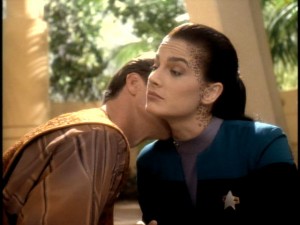
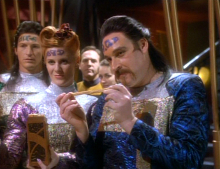
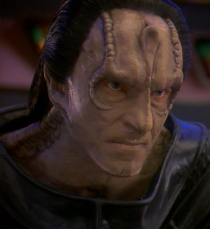
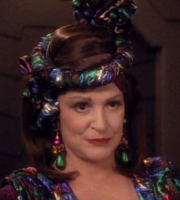
Recent Discussion